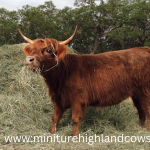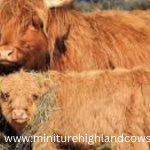The term “miniature Highland cow” is a little misleading. Of course, there are many smaller breeds of cattle, and there is no such thing as the “miniature Highland,” but there is a couple of things to consider.
Mini Highland Cow video
- Smaller Highland Cattle: There are some Highland cattle which are naturally smaller than others due to either genetics or environmental factors. These animals still have the characteristics that make them part of this breed, though, which include their long, shaggy coats and curved horns.
Mini Highland cow baby
Mini Highland cows have long hair and a mild temperament. They are actually the miniature version of traditional Highland cattle. Here are some more details about the Mini Highland cow calves. This includes their characteristics, care, and development:
1. Physical Characteristics
- Size: Obviously, Mini Highland calves weigh less than standard Highland cattle; they weigh between 40 and 60 pounds or 18 to 27 kg at birth.
- Physical appearance: They have the same well-known long, wavy coat as the adults. Their coats may be black, red, brindle, or white. This coat helps protect them against harsh weather conditions.
- Horns: Mini Highland calves are known to start with nubs of horns that grow with them. Horns can be very prominent in adults.
These animals are a friendly, gentle nature to work with; they come from Mini Highland stock; the mini Highlander is often ideal for a small family farm or a homestead. Curiosity and the playful nature often get it into check where the cows investigate surroundings. - Attachment: Attach to their mothers within days of birth and will huddle close for the first weeks of life. Those early attachments are critical to their emotional and social development.
3. Nutritional Needs
Colostrum: Within hours of birth, calves must drink colostrum. This first milk contains precious antibodies and nutrients for an infant’s immune system.
- Milk: In the first three months, a calf only consumes the milk produced by its mother. For additional feeding, supplement with milk replacers is possible.
- Grain/Solid Food: At about three months of age, calves usually become ready for feeding on grain and other grass and hay. This feeding needs to be introduced slowly so that good digestion is maintained.
4. **Health and Care
- Vaccinations: This should form part of health care practices to avoid a number of diseases common with cattle.
- Shelter: A clean dry shelter provides protection from wind and sunshine. Calves are highly sensitive to any extreme condition.
- Socialization is essential in terms of habituating them toward humans as well as towards other animals so that later on they grow up becoming well-balanced adults.
- Growth and Development
- Weaning: Mini Highland calves are weaned from the mothers at an age of 6 to 8 months. During this time, they should be slowly transitioned to a diet that contains more solid food.
- Growth Rate: They grow steadily during their first year, and by the end of the first year, they may weigh between 400 to 600 pounds (180 to 270 kg), depending on genetics.

[Picture of Mini Highland cow]
- Crossbreeding: Another breeders use the smaller breeds to cross-breed with Highland cattle for getting smaller-sized offspring. However, these animals are mostly known as “miniature Highland cows,” although actually they are a cross breed.
[Picture of Cross breed Highland cow]
- Calves: Actually, Highland calves are more smaller in size as an adult cow, which would be mistaken as mini or miniature Highland breed.
[Picture of Highland calf]
Those adorable smaller animals will need all the care and attention the full-sized Highland cattle have. They will need ample pasture, shelter, and diet to be at their best. They could grow up to quite a size depending on the genetics and up-bringing.
If you are choosing Highland cow, then choose proper research on quality breeders and ask if the cow is of known lineage or size?.







FAQs About Miniature Highland Cows
- What are Miniature Highland Cows?
Miniature Highland cows are the smaller version of the standard Highland breed, characterized by long, shaggy coats and a friendly demeanor. They stand between 36 to 42 inches tall at the shoulder. - How much do Miniature Highland Cows weigh?
-Calves born weighing about 40-60 pounds. mature is from 800 to 1,200 pounds depending on genetics and diet. - What colors are Miniature Highland Cows available in?
They can be either black, red, brindle, or white in color. Their coats are long and wavy and are meant to help the animal keep warm in cold winter months. - Are Miniature Highland Cows Good Pets?
- Absolutely! They are gentle and super social. They’re excellent for families and small farms. Early socialization is a must.
- **What Do Miniature Highland Cows Eat?
- Their diet consists of grass, hay, and grains. Calves should be fed colostrum and milk for the first few months and gradually weaned to solid food as they grow.
- How Long Do Miniature Highland Cows Live?
- Mini Highland cows, if well cared for, can live for 15 to 20 years.
- **Do Miniature Highland Cows Need Special Care?
- They need veterinary check-ups, vaccinate them, and ensure their place is clean. They should be groomed too for the sake of not letting their coats become matting.
Miniature Highland Cow Pictures
To be able to appreciate these lovely creatures better, here are some pictures for you of Miniature Highland cows:
- Miniature Highland Calves:
–
- Mature Miniature Highland Cows:
–
- **Miniature Highland Cow Breeds:
–
- Miniature Highland Cow with a Long Coat:
–
These images and FAQs should give you a good overview of Miniature Highland cows! If you have more specific questions or need more information, don’t hesitate to ask.










